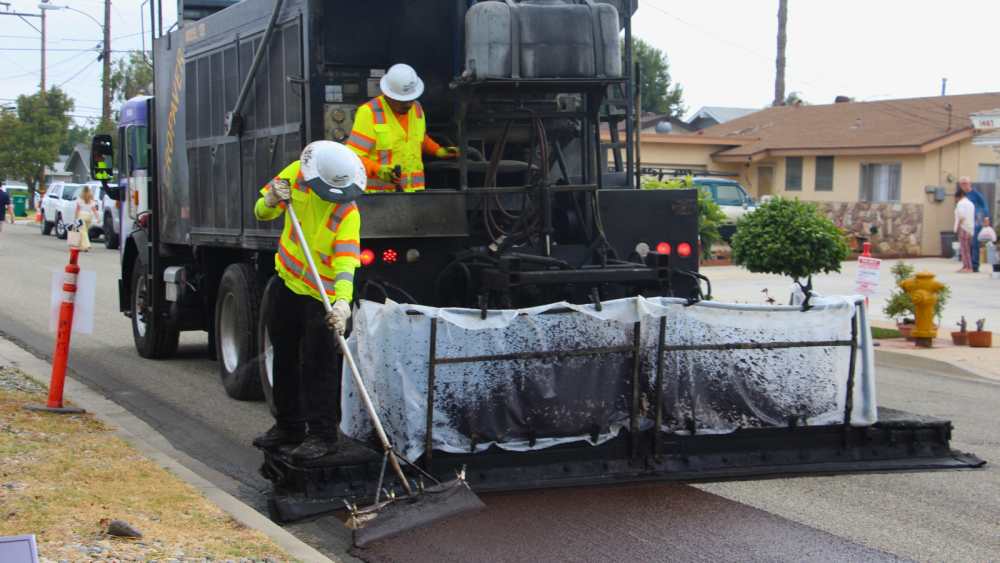250 Miles of Road Resurfacing Completed in FY24
July 3, 2024 | City News Team

Marking a key milestone in efforts to repair and resurface streets citywide, the City of San Diego today celebrated the completion of 250 miles of slurry seal work during the fiscal year that ended June 30 at the final stretch of Jason Street at Signal Avenue in Nestor.
The completion of the multi-month project in the South Bay made fiscal year 2024 one of the most productive years for road-resurfacing in over a decade, underscoring the City’s commitment to investing in infrastructure.
The progress will continue in the coming year, with Mayor Gloria’s “Protecting Our Progress” budget for fiscal year 2025 providing another record level of investment in road repair. The FY25 budget allocates $104.7 million for overlay reconstruction projects and $35.3 million for slurry seal, which will fund approximately 225 miles of overlay and surface seal projects.
“We're making record investments in road repair to address years of insufficient investment that have left these critical public assets in bad shape,” Mayor Todd Gloria said. “San Diegans deserve safe and smooth roads, and this milestone demonstrates our continued commitment to improving streets and neighborhood infrastructure in every community.”
In addition to the slurry seal work in Nestor, teams from the City’s Transportation Department and contracted crews this week have projects under way in Serra Mesa, Navajo, Pacific Beach and Peninsula.
“Completing this many slurry seal miles is a year long process requiring hard work and careful planning from City staff and our resurfacing partners,” said Transportation Director Bethany Bezak. “We appreciate the support from all of our San Diego communities and look forward to continuing our robust paving program into the new fiscal year.”
Slurry seal is a cost-effective pavement preservation method that extends the life of streets already in good condition by 5 to 8 years. Slurry seal is used to prevent the deterioration of streets, which is vital to improving the overall condition of San Diego’s 2,800-mile road network. It reduces the need for a more costly asphalt overlay and reconstruction for badly deteriorated streets.
Asphalt overlay, a more intensive type of road repair, requires larger investment; between design, planning and construction, overlay costs approximately $1.7 million per mile.
The investment from Mayor Gloria’s FY25 budget of $104.7 million will provide funding to complete 75 miles of asphalt overlay, as well as the design and planning needed to complete 105 miles in FY26.
The Transportation Department also has two in-house mill and pave teams that rehabilitate roads to help protect the structural integrity of damaged streets, but in shorter sections than the asphalt overlay process.
Recently, the City implemented two new street resurfacing methods – cape seal and scrub seal – which, similar to slurry seal, extend the life of roads by filling cracks, protecting against moisture incursion and minimizing the development of potholes and other surface deformities. The Transportation Department currently has multiple cape seal projects ongoing in several neighborhoods.
Streets are selected for resurfacing through a pavement management system that helps determine when to schedule streets and which type of repair is appropriate. Each street segment is assigned a Pavement Condition Index (PCI) score based on the pavement’s roughness and cracks.
To prioritize street paving, the PCI is used in conjunction with other factors, such as traffic volume, road type, equity, climate resiliency, mobility, maintenance history, other construction projects, and available funding. Repairs are often grouped within a neighborhood to include streets in similar conditions or performed after other street-disturbing projects, such as pipeline replacement.
View a map of past, current and future street repair in your neighborhood by visiting the City’s interactive StreetsSD map.
Filter by Category
Airports (1)
Arts and Culture (9)
Business (20)
Environment (45)
Human Interest (7)
Library (14)
Parks and Recreation (21)
Personnel (11)
Public Safety (20)
Public Works (58)
Technology (4)
Transportation (1)
Airports (1)
Arts and Culture (9)
Business (20)
Environment (45)
Human Interest (7)
Library (14)
Parks and Recreation (21)
Personnel (11)
Public Safety (20)
Public Works (58)
Technology (4)
Transportation (1)
